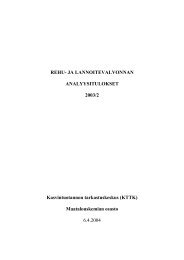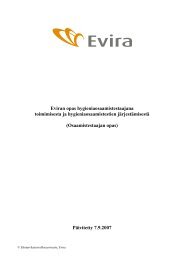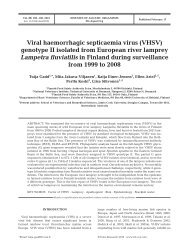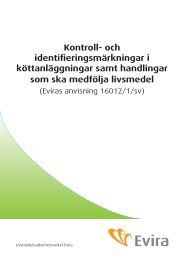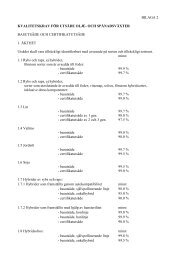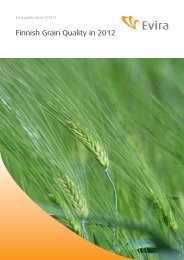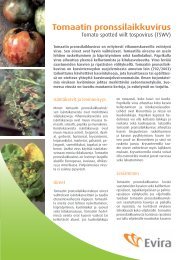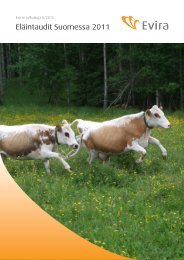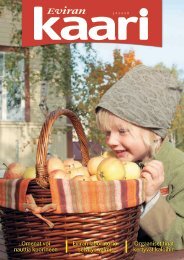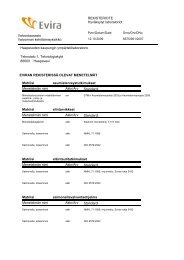Genetic characteristics of field and attenuated rabies viruses ... - Evira
Genetic characteristics of field and attenuated rabies viruses ... - Evira
Genetic characteristics of field and attenuated rabies viruses ... - Evira
You also want an ePaper? Increase the reach of your titles
YUMPU automatically turns print PDFs into web optimized ePapers that Google loves.
Vector vaccines are based on recombinant <strong>viruses</strong>, <strong>and</strong> several <strong>viruses</strong> have been<br />
tested for these purposes. The VRG vaccine was designed on the basis <strong>of</strong> poxvirus<br />
(vaccinia virus) expressing SAD strain glycoprotein <strong>and</strong> used for oral immunization <strong>of</strong><br />
wildlife (Wiktor et al., 1984; Brochier et al., 1990, 1991; Winkler et al., 1992; Meslin et al.,<br />
1994). The Adrab.gp - vaccine is based on the adenovirus expressing the ERA strain<br />
glycoprotein <strong>and</strong> was found capable <strong>of</strong> inducing an immune response in dogs (Tims et<br />
al., 2000). The canine herpesvirus (CHV) expressing the glycoprotein <strong>of</strong> <strong>rabies</strong> virus has<br />
also been used successfully as an anti-<strong>rabies</strong> vaccine (Xuan et al., 1998). A raccoon<br />
poxvirus (RCNV) recombinant vaccine for the immunization against feline panleukopenia<br />
<strong>and</strong> <strong>rabies</strong> has been developed <strong>and</strong> tested in cats (Hu et al., 1997). A recombinant <strong>rabies</strong><br />
virus vaccine carrying two identical glycoprotein (G) genes (SPBNGA-GA) has also been<br />
constructed (Faber et al., 2002).<br />
The <strong>rabies</strong> virus vaccine strain based on vectors have shown great promise as<br />
vaccines against other viral diseases such as human immunodeficiency virus type 1<br />
(HIV-1) infection <strong>and</strong> hepatitis C, but a low residual pathogenicity remains a concern for<br />
their usage (McGettigan et al., 2003).<br />
Plant-derived antigens can also be used for the immunization against <strong>rabies</strong>. The<br />
coat protein <strong>of</strong> alfalfa mosaic virus has been used as a carrier molecule to express the<br />
antigenic peptides from <strong>rabies</strong> virus. The in vitro transcripts <strong>of</strong> the recombinant virus with<br />
sequences encoding the antigenic peptides have been synthesized from DNA constructs<br />
<strong>and</strong> used to inoculate tobacco plants. The plant-produced protein (virus particles) has<br />
been purified <strong>and</strong> used for the immunization <strong>of</strong> mice, <strong>and</strong> specific anti-<strong>rabies</strong> virusneutralizing<br />
antibodies in immunized mice have been found (Yusibov et al., 1997;<br />
Modelska et al., 1998); spinach has also been used for this purpose (Koprowski, 2002).<br />
The transgenic maize expressing the G protein <strong>of</strong> the Vnukovo strain has also been<br />
obtained <strong>and</strong> tested in mice. It was shown that the mice developed virus neutralizing<br />
antibodies which were able to provide protection <strong>of</strong> 100% against the challenge <strong>of</strong> a<br />
vampire bat strain (Loza-Rubio et al., 2007).<br />
Oral vaccination <strong>of</strong> wildlife against <strong>rabies</strong>. Before the era <strong>of</strong> oral vaccines, the only<br />
feasible measure for controlling <strong>rabies</strong> in wildlife was the depopulation <strong>of</strong> reservoir<br />
species (Aubert, 1994); but currently <strong>rabies</strong> is the only zoonosis that can be controlled by<br />
the oral vaccination <strong>of</strong> wildlife. The idea <strong>of</strong> conducting active immunization <strong>of</strong> wildlife<br />
appeared in the last century (Baer, 1975), but many difficulties, such as the form <strong>of</strong> the<br />
vaccine, methods <strong>of</strong> distribution <strong>and</strong> uptake control, <strong>and</strong> possible residual pathogenicity<br />
27



